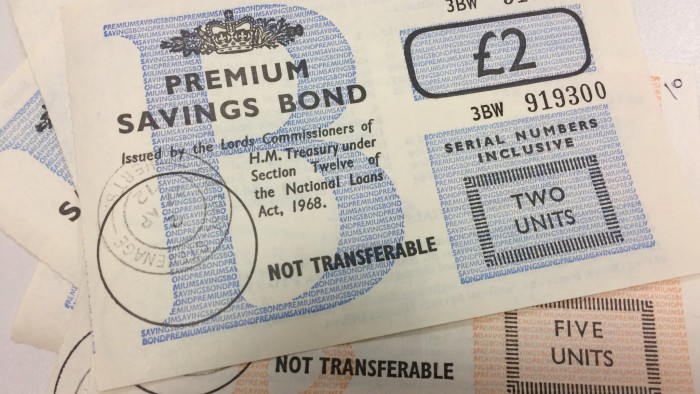Are premium bonds still worth it?

Simply sign up to the UK banks myFT Digest -- delivered directly to your inbox.
Many of us dream of winning £1m on the premium bonds. But the chances of hitting this jackpot are about to be reduced, with the provider of the much-loved savings product also trimming the number of high value prizes.
This week, National Savings & Investments said it would lengthen the odds of winning a prize on the premium bonds from 26,000 /1 to 30,000/1, in a change that will apply from June.
The “prize rate” on the products, which is often compared to an interest rate on a bank account, will fall from 1.35 to 1.25 per cent. The monthly draw will retain its two £1m jackpot prizes, but the overall prize fund will be cut. The numbers of small cash prizes worth £50 and £100 will increase, but the number of those worth £500 and over will be reduced. For example, five £100,000 prizes were offered in March, but there will only be two in June.
This, financial advisers say, is another reason to be wary of putting money into premium bonds instead of pensions, Isas or best-buy savings and current accounts.
“People do enjoy owning premium bonds and giving them to children, but we wouldn’t recommend them as part of core financial planning,” says Michelle Gibbs of financial adviser Helm Godfrey.
Nevertheless, premium bonds are one of the nation’s most popular savings product with 21m Britons holding them, according to provider NS&I. Individuals can hold a maximum of £50,000 after the limit was upped last year. They were introduced in 1956 by Harold Macmillan, who wanted to reduce inflation and offer an alternative way to save.
Seen as a hybrid between a savings product and a lottery, they are really a method of lending money to the government. Unlike other debt products, however, they pay no interest. Instead, NS&I sets a “prize rate” that is a proportion of all the premium bonds in issue. In June, for example, the fund will be just under £63m, which is 1.25 per cent of the value of bonds eligible for the monthly prize draw.
A history of premium bonds
- Premium bonds were launched on Budget day, 17 April 1956, by Harold Macmillan, with a top prize of £1,000.
- Alderman Sir Cuthbert Ackroyd, the Lord Mayor of London, bought the first one.
- By the end of that first day, £5 million worth of Premium Bonds had been sold.
- The monthly £1 million jackpot was introduced in 1994.
- An additional jackpot prize of £1 million was introduced in 2005.
But people who hold premium bonds for the long term should not expect to get a 1.25 per cent return on their investment, warns Laith Khalaf of investment sales platform Hargreaves Lansdown.
“The prize fund is just a pool of money, and that fund is split unevenly between the winners. So if you have average luck over the long term, you would receive this interest rate, but of course you can have below-average or above-average luck,” he explains.
Considering the odds, average luck will not win you much, either, compared to the interest you could be receiving — and compounding — on the best current accounts on the market. According to MoneySavingExpert, which has a premium bonds prize probability calculator on its website, someone who bought £1,000 of premium bonds and held them for five years could expect to win £10 a year.
Moneyfacts, which compares information on financial products, identifies three current accounts that pay between 3 to 5 per cent. These are offered by Nationwide (5 per cent for 12 months), TSB (5 per cent on balances up to £2,000) and Tesco Bank (3 per cent up to £3,000).
Despite their popularity, are premium bonds really suitable for anyone? Ms Gibbs and Mr Khalaf say they can be a good option for wealthy people who have maxed out their pension contributions, their Isa allowances and the amount of money they can hold in bank accounts that are covered by the government’s deposit protection scheme.

“One advantage of premium bonds is that they are 100 per cent backed by the Treasury,” says Mr Khalaf. Winnings are also tax free.
“Don’t forget there is always that possibility of winning,” says Robin Melley of Matrix Capital, who acts on behalf of NS&I to help premium bond jackpot winners plan and manage their finances. “I advised a young couple who had put a few thousand pounds in, against the advice of their relatives. They won the jackpot and bought a house outright.”
Mr Melley, who is not allowed to identify the clients, added that with interest rates on many savings accounts and cash Isas currently at rock bottom, “the prize fund rate isn’t too bad. If you strip out the two £1m jackpots, it nets out at about 1.1 — 1.2 per cent, which is about the same as an instant access deposit. The money is also fully guaranteed.”
If this article has prompted you to scour your attic for old bond certificates, the NS&I website has a special section with advice on tracing and re-registering bonds to see if you have won a prize. The modern world is such that there is also now a smartphone app that can tell you instantly if you have won. Good luck.
Comments